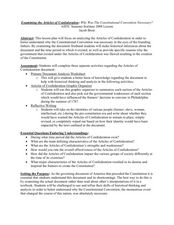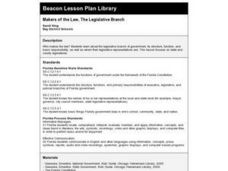Curated OER
How Has the Constitution Shaped the Economic System in the United States?
Students examine the characteristics of market economies. In this United States economics lesson, students analyze the Constitution to understand how it contributes to the market economy established in the United States. Students...
Curated OER
Judges in the Classroom Lesson Plan Classifying Rights From Various Constitutions
Fourth graders compare the constitutions of five Pacific Rim countries. In this constitution comparison lesson, 4th graders work with a visiting judge to find similarities and differences in the constitutions of five countries. They...
Curated OER
What Does The Preamble of the U.S. Constitution Mean?
Students begin the lesson plan by comparing and contrasting two state constitution's preambles. After identifying the themes in the state preambles, they compare the U.S. Constitution's preamble to the states. They work together to...
Curated OER
Why was the Constitutional Convention Necessary?
Eleventh graders explore the steps leading up to the Constitution. In this American Government lesson, 11th graders practice document based questions. Students create a letter that describes how a person felt during this...
Curated OER
The Constitution and The Bill of Rights
Learners explore the Constitution, the convention and the Bill of Rights with a wide variety of on-line activities including the framers, primary sources, court cases and games.
Curated OER
US Government: The Checks and Balances System of the US Constitution
Students examine the responsibilities of the 3 branches of U.S. government. In this checks and balances lesson, students identify the powers of the legislative, executive, and judicial branches of government. Students share examples of...
Curated OER
Law, Values and Lobbying
Students begin to examine the lawmaking process. Using their text, they describe the role of the three branches of government. In groups, they identify the four basic values protected by law and define the concept of lobbying and...
Curated OER
Social Studies: Segregation, Jim Crow Laws, Plessy vs. Ferguson
Young scholars examine the concept of segregation. In this civil rights instructional activity, students discuss the separate but equal theory as well as the Plessy vs. Ferguson decision. Young scholars also research women of the Civil...
National Endowment for the Humanities
James Madison: Madison Was There
Madison was there! Scholars go on a journey to discover the person behind the founding father label as they explore James Madison's role in the formation of the United States government. The culmination is a writing assignment and...
Heritage Foundation
Procedural Amendments: Amendments III, IV, and V
So many US Constitution clauses, so little time. The 17th installment in a 20-part series teaches pupils about the Third, Fourth, and Fifth Amendments. Learning through activities such as group work, connecting to current events, and...
Heritage Foundation
Congress's Territorial Powers, Implied Powers, Citizenship, and the Bureaucracy
An informative resource gives scholars a look into why the US Constitution placed certain federal powers over that of the state. A variety of activities about constitutional clauses helps to create meaningful learning.
Curated OER
Makers of the Law, The Legislative Branch
Students, in teams, research the legislative branch and complete a "Legislative Information List." Teams research different parts of the list and jigsaw teach the other groups about each part. One group researches names of state officials.
Curated OER
Andrew Jackson and the Use of Martial Law and the Suspension of Habeas Corpus
High schoolers explore the use of martial law at the Battle of New Orleans. In this Andrew Jackson lesson, students analyze primary documents pertaining to the move by Jackson to use martial law in the battle. High schoolers then...
Curated OER
Environmental Law-Making
Students go through the process of creating and passing a federal law. They select an environmental issue, research related policies for the issue, draft the bill, discuss it among committee members, bring it before the class and bring...
Curated OER
Should Homosexuals Have the Right to Laws Protecting Them From Discrimination?
Students explore discrimination issues in America. For this homosexual rights lesson, students listen to their instructor lecture on antidiscrimination laws and gay rights. Students respond to questions about the Romer v. Evans case.
National Constitution Center
Separation of Powers
Learners explore how the Constitution provides for separation of power and limited government, as evidenced by the three branches of government. They participate in role-playing situations, group discussions, and complete worksheets to...
Pacific University Oregon
Civil Rights: US History
To gain an understanding of the Civil Rights Movement of the 1960s, class members investigate the Jim Crow Laws, the Emancipation Proclamation, the 13th, 14th, and 15th Amendments of the US Constitution, and the 1898 Supreme Court case,...
C-SPAN
14th Amendment Equal Protection Clause
Two Supreme Court cases, Plessy v. Ferguson and Brown v. Board of Education take center stage in a lesson about the Equal Protection Clause of the 14th Amendment. Class members research both cases to compare and contrast the rulings.
Constitutional Rights Foundation
Slavery and the Electoral College
How did slavery mold the creation of the US Constitution? The final lesson in the series focuses on how slavery impacted the creation of the Electoral College. Academics learn how the Electoral College was created because Southern states...
Judicial Learning Center
About Federal Judges
Not just anybody can do the job of a federal judge, but according to the United States Constitution just about anybody can be appointed. The lesson outlines the process and requirements for becoming a federal judge, focusing on the...
Constitutional Rights Foundation
270 Votes to Win: The Electoral College in the United States
What exactly is the Electoral College and how does it work? The lesson is part of a larger series on government that explains what the Electoral College is and how it helps determine an election winner. Academics participate in...
Carolina K-12
Citizens United v. Federal Election Commission & the First Amendment
Should Congress limit how much a corporation spends to support a political candidate? Here is a fantastic lesson plan and activities to help young citizens approach this question.
Law Focused Education
Federalist — Anti-Federalist
Deciding how to rule a nation is no easy task. Scholars use an online quiz to test their knowledge of Federalist and Anti-Federalist positions, ideas on the Articles of Confederation, and finish with questions on the United States...
Anti-Defamation League
Women's Suffrage, Racism, and Intersectionality
The Nineteenth Amendment granted women the right to vote—as long as they were white. High schoolers read articles and essays about racism in the suffrage movement and consider how intersectionality played a role in the movement. Scholars...

























